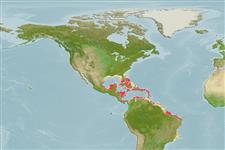Klassifizierung / Names
Namen | Synonyme | Catalog of Fishes(Gattung, Arten) | ITIS | CoL | WoRMS | Cloffa
>
Eupercaria/misc (Various families in series Eupercaria) >
Scaridae (Parrotfishes) > Scarinae
Etymology: Scarus: Greek, skaros = a fish described by anciente writers as a parrot fish; 1601 (Ref. 45335).
Environment: milieu / climate zone / depth range / distribution range
Ökologie
seewasser riff-verbunden; tiefenbereich 3 - 25 m (Ref. 9710). Tropical; 39°N - 24°S, 98°W - 31°W
Western Atlantic: Maryland in the USA, Bermuda and Bahamas to Rio de Janeiro, Brazil (Ref. 13628), including the West Indies (Ref. 3802); absent in the northern Gulf of Mexico.
Length at first maturity / Size / Gewicht / Alter
Maturity: Lm ?, range 31 - ? cm
Max length : 120 cm TL Männchen/unbestimmt; (Ref. 7251); common length : 35.0 cm TL Männchen/unbestimmt; (Ref. 3802)
Rückenflossenstacheln (insgesamt) : 9; Rückenflossenweichstrahlen (insgesamt) : 10; Afterflossenstacheln: 2; Afterflossenweichstrahlen: 9. Adults uniformly blue, with yellow area on top of head that disappears in larger fish. Large fish develop prominent bulging snout and extended upper and lower caudal fin lobes. No other species has this uniform blue color in adults. (Ref. 26938).
Inhabits coral reefs. Juveniles found on Thalassia beds (Ref. 13628). Feeds on benthic plants and small organisms in the sand (Ref. 5521). Forms large spawning aggregations (Ref. 9710).
Life cycle and mating behavior
Geschlechtsreife | Fortpflanzung | Ablaichen | Eier | Fecundity | Larven
Oviparous, distinct pairing during breeding (Ref. 205).
Parenti, P. and J.E. Randall, 2000. An annotated checklist of the species of the labroid fish families Labridae and Scaridae. Ichthyol. Bull. J.L.B. Smith Inst. Ichthyol. (68):1-97. (Ref. 35918)
IUCN Rote Liste Status (Ref. 130435: Version 2024-2)
Bedrohung für Menschen
Reports of ciguatera poisoning (Ref. 4690)
Nutzung durch Menschen
Fischereien: weniger kommerziell; Sportfisch: ja; Aquarium: Kommerziell
Tools
Zusatzinformationen
Download XML
Internet Quellen
Estimates based on models
Preferred temperature (Ref.
123201): 26.1 - 28.2, mean 27.4 °C (based on 685 cells).
Phylogenetic diversity index (Ref.
82804): PD
50 = 0.5000 [Uniqueness, from 0.5 = low to 2.0 = high].
Bayesian length-weight: a=0.01288 (0.00726 - 0.02285), b=3.04 (2.89 - 3.19), in cm total length, based on LWR estimates for this species & Genus-body shape (Ref.
93245).
Trophic level (Ref.
69278): 2.0 ±0.00 se; based on food items.
Generation time: 3.4 ( na - na) years. Estimated as median ln(3)/K based on 1
growth studies.
Widerstandsfähigkeit (Ref.
120179): mittel, Verdopplung der Population dauert 1,4 - 4,4 Jahre. (Preliminary K or Fecundity.).
Fishing Vulnerability (Ref.
59153): Moderate vulnerability (42 of 100).
Nutrients (Ref.
124155): Calcium = 21.2 [13.4, 36.4] mg/100g; Iron = 0.618 [0.415, 0.940] mg/100g; Protein = 18.9 [16.7, 20.7] %; Omega3 = 0.0733 [, ] g/100g; Selenium = 24.4 [14.4, 40.4] μg/100g; VitaminA = 26.2 [7.6, 89.8] μg/100g; Zinc = 1.64 [1.22, 2.15] mg/100g (wet weight);
